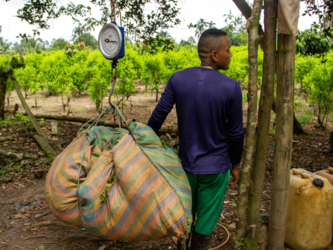The plummeting price of coca in some of Colombia’s cultivation hotspots is unlikely to affect major drug trafficking operations despite forcing farmers out of growing the crop.
Prices of coca, the source plant for cocaine, have fallen dramatically in the last seven months. Colombia’s most important coca-growing departments, including Nariño, Putumayo, Norte de Santander, and Cauca, have been particularly affected.
Farmers have seen point of sales prices drop by almost two-thirds, from as high as $1.37 per kilogram of coca to $0.52, according to El Tiempo.
SEE ALSO: Colombia Sees Historic Levels of Coca Cultivation and Cocaine Production
Residents in the department of Meta have traditionally used coca paste that they would produce from coca as a form of currency, with traders trusting it would keep its value. However, farmers now find themselves unable to barter their crop for basic goods, according to El Cuarto Mosquetero.
Unable to earn, cultivators and coca-growing communities are struggling to buy food. Last month, President Gustavo Petro noted on Twitter that “the absence of coca paste buyers has led to hunger in coca-growing territories.” Farmers are planting alternative crops or relocating entirely.
The price collapse has happened following record levels of cultivation in recent years, which came despite extensive eradication campaigns.
President Gustavo Petro’s government, inaugurated last year, has criticized past eradication efforts for targeting the lowest rung of the criminal food chain. The administration has almost entirely halted coca eradication efforts, shifting instead to focus on seizing processed cocaine from major trafficking organizations.
InSight Crime Analysis
Reasons for the price crash are uncertain, but experts predict that continued demand for cocaine means the coca crisis is unlikely to seriously impact drug trafficking.
Demand for cocaine in international markets remains high, meaning traffickers can afford to pay far more than the rock-bottom prices that are currently pushing coca farmers to look to alternative crops.
In traditional coca cultivation hotspots like Tumaco in Nariño, the volume of the coca trade is already returning to normal, suggesting the market is showing signs of recovery, according to Diego García Devis, drug policy team manager at Open Society Foundations.
“This won’t be permanent,” García Devis told InSight Crime.
Even if some farmers switch crops, there will still be plenty of coca to meet global demand, García Devis added.
“There is always an overproduction of coca leaf in the cocaine production process, counting on the results of interdiction or eradication,” he said.
SEE ALSO: Peace Dissipates as the Cocaine War Intensifies in Putumayo
Coca cultivation figures for this year could reach a new record of 300,000 hectares, said García Devis.
Among the possible reasons behind the price fall, including an absence of buyers and organized criminals setting up their own growing operations, though reasons differ according to subregions, he said.
“There is no single explanation for this phenomenon,” he said, adding that a glut of coca due to record-high levels of coca cultivation was unlikely behind the price crash.
Cristian José Arias Barrera, who researches links between coca and violence in the country, also dismissed the idea that a glut of coca leaf had tanked the market. Previous eradication drives had little effect on the amount of coca being grown, he said.
A lack of buyers has been suggested by coca farmers as a reason behind the price collapse. The October 2021 capture of Dairo Antonio Úsuga, alias “Otoniel,” leader of the Gaitanistas and at that point the country’s most-wanted drug trafficker, left farmers in Catatumbo, Norte de Santander without a reliable buyer, La Silla Vacía reported.
Drug traffickers who worked with Otoniel may fear that he gave authorities information that could implicate them, according to experts cited by Verdad Abierta.
The rising price of gold is attracting some drug trafficking organizations to turn to illegal mining, Colombian news outlet Cambio reported. Organized crime groups in the southern parts of Bolívar and Córdoba are telling farmers not to sow crops, the country’s crop substitution director told the outlet.
Some traffickers who had previously only bought coca are also now reportedly taking over the entire production process, including growing crops, in order to improve quality, cutting out traditional farmers in the process.
Meanwhile, the National Liberation Army (Ejército de Liberación Nacional – ELN) appears to have stopped engaging in drug trafficking activity in Cauca ahead of peace negotiations with the government, leaving farmers there without a buyer, García Devis said.

